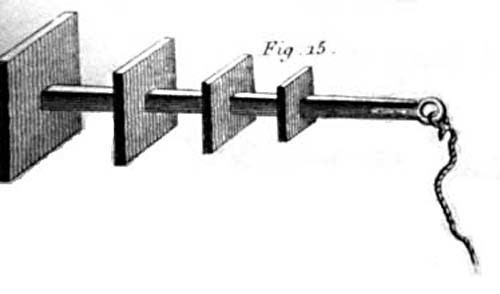 | ||
A sea anchor (also known as a drift anchor, drift sock, para-anchor or boat brake) is a device used to stabilize a boat in heavy weather. Rather than tethering the boat to the seabed, the sea anchor increases the drag through the water and thus acts as a brake. When attached to the stern of a vessel, a sea anchor can prevent the vessel from turning broadside to the waves and being overwhelmed by them.
Contents
Often similar in design to the sea anchor is the usually smaller drogue, which is attached to the stern and intended to slow the boat for better control.
Design
Anything that can act as a source of drag in the water can act as a sea anchor; a common improvised sea anchor is a long line (a docking warp or anchor rode) paid out into the water; while this does not provide much drag, it can act as a drogue and aid in running downwind. In The Sea-Wolf, author and sailor Jack London described using various torn spars and sails, tied to a line, as an improvised sea anchor. A sail, weighed down with an anchor chain or other heavy object, will also work as an improvised sea anchor.
Early sea anchors were often improvised from spare parts aboard ship. An 1877 book used by the United States Naval Academy describes methods of making sea anchors. These took the form of a wooden or metal framework forming a simple kite-like shape of sail canvas, backed with a net or closely spaced ropes to provide strength. A small anchor attached to one corner kept the sea anchor from twisting. If the framework was wooden, the wood's buoyancy kept the sea anchor just under the surface, while an iron framework used a buoy to keep it at the proper depth.
Modern commercial sea anchors are usually made of cloth, shaped like a parachute or cone, and rigged so that the wider end leads and the narrower end trails. When deployed, this type of sea anchor floats just under the surface, and the water moving past the sea anchor keeps it filled. Some varieties are cylindrical, with an adjustable opening in the rear that allows the amount of braking to be adjusted when deployed.
The size of the sea anchor determines how much water it can displace, and how much braking it can provide. It is also possible to use more than one sea anchor to increase the braking, and one type, the series drogue, consists of many small anchors spread out along a line to ease retrieval under heavy conditions.
Most larger sea anchors will provide a mechanism to collapse the anchor for retrieval. This is called a trip line, and attaches to the rear of the anchor, allowing it to be pulled in back first, shedding water rather than filling. This trip line can be rigged a number of ways, depending on the preference of the user.
Use
Sea anchors can be used by vessels of any size, from kayaks to commercial fishing vessels, and were even used by sea-landing naval Zeppelins in World War I. While the purpose of the anchor is to provide drag to slow the vessel, there are a number of ways this can be used:
The length and type of the line, or rode, used to attach the sea anchor to the bow is also important. In addition to connecting the sea anchor to the hull, the rode also acts as a shock absorber. The stretching of the rode under load will smooth out the changes in loading caused by the changing force of the waves interacting with the hull of the vessel. Because a high degree of stretch is desirable in this application, a material with a low elastic modulus is preferred, such as nylon. If there is no concern about breaking waves and the only reason the sea anchor is being used is to reduce drift from the wind, then you can use a short rode. If short rode is used on large ocean swells, its length should be tuned to the wavelength of the waves; either under 1/3 of the wavelength, or an even multiple of the wavelength. A line significantly shorter than the wavelength means the anchor and hull will ride over the crests together, while a line equal to the wavelength will keep the hull and anchor from ending up out of phase, which can result in severe loading on the anchor. In stormy seas, and when breaking waves are a concern, it is important not to tune the rode length to the waves, so that the anchor and boat are not rolled by the same wave or by adjacent waves. The ability to absorb shock is even more important. Under these conditions, a rode as much as 10 to 15 times the length of the hull should be used to provide a high degree of shock absorption.
